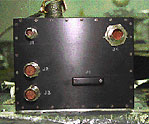Gyroscopes/Rate Sensor Unit (RSUs)-The gyroscopes help Hubble point and move by continuously reporting the telescope's position and any small movement it makes. This information is sent to a computer that commands Hubble to stay stable or move at a desired rate.
Each gyro contains a spinning wheel inside a sealed container. Hubble's movement is constantly compared to the position of these spinning wheels. By keeping Hubble steady with respect to these wheels, the telescope stays stable.
Hubble has six gyroscopes. They are grouped in pairs inside three Rate Sensor Units (RSUs). Any three gyroscopes can keep Hubble fully operating. In 1997, at the end of Servicing Mission 2, all six gyroscopes were working normally. From January 1999 until November 13, 1999, Hubble had been operating with only 3 functional gyroscopes, making it highly desirable to restore the remaining three. On November 13, 1999 Hubble lost 4th gyro and was placed into safe-hold mode. All the gyros were replaced and were fully functional at the end of the servicing mission. Hubble is now functioning normally.
In addition to new gyros, Hubble has been fitted with other new and better instruments. A Fine Guidance Sensor keeps Hubble locked onto its targets. The New Advanced Spacecraft Computer is 20 times faster with six times more memory. It will also cost less money to operate.
 |
|
|
FGS
|
Advanced
computer
|
Hubble runs on solar power during the daylight hours. The solar arrays are long sheets that look like wings. These collect sunlight and use the sun's energy to run Hubble. Some of this energy is stored in batteries that Hubble uses for power at night (night happens every 45 minutes in space!). The new Voltage/Temperature Improvement Kits protect Hubble's six batteries from overcharging and breaking.
 |
 |
The Shell/Shield Replacement Fabric is flexible, aluminized Teflon® sheets of fabric. The fabric wraps around the top of the telescope, where sunlight hits it the most. The telescope is just like a house or even a cup holder that has insulation to keep the inside stuff cool. *Not completely installed because of the shortened mission duration (3 EVA days instead of 4)
To change the Rate Sensor Units, which contain the gyroscopes, the astronauts must open Hubble's aft shroud doors. Pressure has bent the latch to these doors. Astronauts will fix the latch with the Aft Shroud Latch Repair Kit. *Not completely installed because of the shortened mission duration (3 EVA days instead of 4)
Things are weightless in orbit. Because of this, astronauts need tools or aids to help them move around the telescope. Some of these aids are called handrails. These are like rails on stairs or playground equipment. On the Second Servicing Mission, astronauts saw some paint peeling off the handrails. These paint flakes could get inside the telescope and cover parts of the mirror or break instruments. To stop this from happening, astronauts will wrap Handrail Covers over the rails. These covers are shaped like sleeves and made of a special fiberglass cloth.






